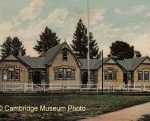Cambridge Collections
Cambridge Primary School

The Ten Star Redoubt (behind the present Museum) was home for the first school in Cambridge.
In January 1865 the militiamen were allotted farms from confiscated land around the Cambridge district. Wives and children arrived and the school was run in the redoubt by Thomas Spedding. The Militia was disbanded in 1867 and by this time many soldiers had become disillusioned with the government’s promises and farming.
In 1869 the Common Schools Act, passed by the Auckland Provincial Council proclaimed Cambridge as one of 10 educational districts. William Cunningham arranged for the disused hospital building at the foot of Duke Street hill, to become the school and with £60 from government and £60 promised by the settlers, Mr Bremner became the school master.
The beginning of the present Cambridge Primary School building was dragged from the bottom of Duke Street hill to the present school site in 1874. It was partitioned off to also house the Cambridge Library which, in 1877, moved next to the Post Office on Victoria Street.
By that time the schoolroom was in need of repair and the Education Board granted the committee £45 towards the costs.
By 1880 the head teacher, Ralph Stewart and three assistants had two classrooms and porches, all of pit-sawn Kauri. The roll stood at 191 and until this time, when the Cambridge West (Leamington) School was opened, children from both sides of the river had attended the school at Cambridge East.
In 1881 Rebecca and Margaret Young opened ‘Linton’ in Hamilton Road, a private school for girls. At the same time another classroom was added to the Cambridge Primary. The High School was opened on 2 July 1883 with a fee of £8 8/- for each of the 23 pupils. But four years later in 1887, the High School closed. At this time Miss Gray and Miss Cussen opened a private Catholic School with 14 pupils.
In 1886 the boys’ schoolroom had been added and this was the first high gabled building running parallel to Duke Street. In 1900 two of the original rooms built in 1879 and 1881, were moved beside this building and the original ‘hospital’ building was demolished.
Also at the beginning of the century the rolls increased as the large estates went financially broke and were cut up by the government, the dairy industry gained momentum and more families came into the area.
In 1902 the High School reopened with a roll of 17 pupils and in 1904 there was another room, porch and staff room added. This provided accommodation for 70 more children and made up the four gable facade we see today.
A Manual and Technical School was built in 1908 (next to the Old Courthouse in Victoria Street) and the Primary added another acre of land to their grounds in 1909. At that time the staff consisted of the headmaster, Mr W R C Walker, four assistants and two pupil teachers.
The roll was over 300 and accommodation was stretched again until in 1916 the High School pupils were resited in the Manual School and then in Mr Blackman’s empty Auction Mart. Five new rooms were added in 1921 and, through generous donations, hot chocolate was available to pupils at 1 penny a week. Another two rooms were built in 1925, as the roll stood at 494 and this created the present classroom block, remodelled again in 1981.
The High School, with a roll of 85 pupils, moved into three new rooms in Clare Street in February 1927. The teacher was Mr Griffith Jones.
The Primary School Dental clinic was also opened in 1927 and evening classes were started in 1930. There was a drop in the Primary School rolls during the 1930’s depression with the exclusion of five year olds, but after World War Two overcrowding again put classes in the corridors.
In 1937 new certificates replaced Proficiency, and milk in schools started in 1938 with Mr Worms delivering to Cambridge, Leamington, Hautapu and Goodwood. 1947 saw a new School Bus service run by Buses Limited and the start of the Parent-Teacher Association.
In 1950, when there were more than 500 pupils on the Primary School roll, the High School built two more rooms to accommodate Forms One and Two. There was further relief in 1955 when Cambridge East opened in Bowen Street with 146 pupils and Mr Leslie Bear as Head Teacher.
The Independent newspaper records in 1964 – “Of greater importance in the life of the school than the growth of buildings, playgrounds and facilities, has been the flow of human material through its rooms and corridors – pupils, teachers, parent helpers”.
Today this would still be the most important growth of the Cambridge Primary Schools.
The Cambridge Primary School is listed in Catergory 1 with New Zealand Historic Places Trust.
